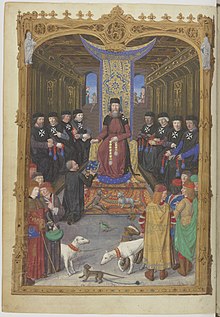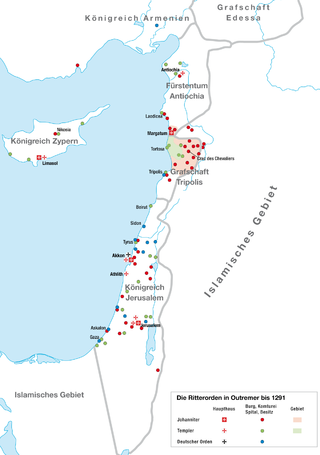
A military order is a Christian religious society of knights. The original military orders were the Knights Templar, the Knights Hospitaller, the Order of Saint James, the Order of Calatrava, and the Teutonic Knights. They arose in the Middle Ages in association with the Crusades, both in the Holy Land, the Baltics, and the Iberian peninsula; their members being dedicated to the protection of pilgrims and Christians, as well as the defence of the Crusader states. They are the predecessors of chivalric orders.

Krak des Chevaliers is a medieval castle in Syria and one of the most important preserved medieval castles in the world. The site was first inhabited in the 11th century by Kurdish troops garrisoned there by the Mirdasids. In 1142 it was given by Raymond II, Count of Tripoli, to the order of the Knights Hospitaller. It remained occupied by them until it was reconquered by the Muslims in 1271.

Bunratty Castle is a large 15th-century tower house in County Clare, Ireland. It is located in the centre of Bunratty village, by the N18 road between Limerick and Ennis, near Shannon Town and its airport. The castle and the adjoining folk park are run by Shannon Heritage as tourist attractions.

Cratloe is a village in County Clare, Ireland, situated between Limerick and Shannon in the mid-west of Ireland. It is possible that the name derives from Croit-shliabh meaning "hump-backed hill", referring to Woodcock Hill. The present-day parish of Cratloe consists of the former parish of Kilfintinan and a portion of the contemporary parish of Killeely. This was agreed upon by priests in the 18th century, who claimed there were not enough members of the clergy to operate fully in both parishes.
Hospital is a village in east County Limerick, Ireland. It is also a civil parish in the ancient barony of Smallcounty. The village's population was 653 as of the 2016 census. The village itself is situated in the townland of Barrysfarm, one of 11 in the civil parish. It lies on the River Mahore, a tributary of the River Camogue.

Limerick, in western Ireland was the scene of two sieges during the Irish Confederate Wars. The second and largest of these took place during the Cromwellian conquest of Ireland in 1650–51. Limerick was one of the last fortified cities held by an alliance of Irish Irish Confederates and Royalists against the forces of the English Parliament. Its garrison, led by Hugh Dubh O'Neill, surrendered to Henry Ireton after a protracted and bitter siege. Over 2,000 soldiers of Cromwell's New Model Army were killed at Limerick, and Henry Ireton, Cromwell's son-in-law, died of plague.

Corcomroe Abbey is an early 13th-century Cistercian monastery located in the north of the Burren region of County Clare, Ireland, a few miles east of the village of Ballyvaughan in the Barony of Burren. It was once known as "St. Mary of the Fertile Rock", a reference to the Burren's fertile soil.
A fortified church is a church that is built to serve a defensive role in times of war. Such churches were specially designed to incorporate military features, such as thick walls, battlements, and embrasures. Others, such as the Ávila Cathedral were incorporated into the town wall. Monastic communities, such as Solovki Monastery, are often surrounded by a wall, and some churches, such as St. Arbogast in Muttenz, Switzerland, have an outer wall as well. Churches with additional external defences such as curtain walls and wall towers are often referred to more specifically as fortress churches or Kirchenburgen.

Killulta Church is a medieval church and a National Monument in County Limerick, Ireland.

Kilrush Church, also called St. Munchin's Church, is a medieval church and a National Monument in Limerick City, Ireland.
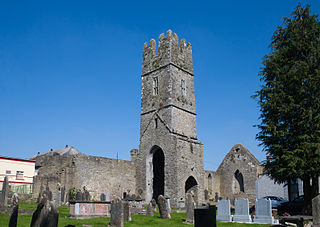
Roscrea Friary is a ruined medieval Franciscan friary and National Monument located in Roscrea, County Tipperary, Ireland. It is on Abbey Street, in the west end of Roscrea, on the north bank of the River Bunnow. The Friary was founded in the 15th century by Greyfriars (Franciscans) and later destroyed by British soldiers. What remains are the north and east walls and the bell-tower.
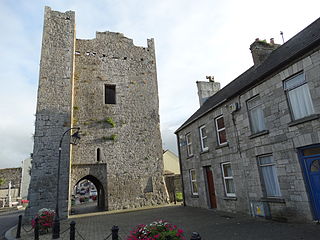
King John's Castle or King's Castle is a tower house and National Monument located in Kilmallock, Ireland.

Mungret Abbey is a medieval friary and National Monument located near Mungret in County Limerick, Ireland.

The Priory Church of Saint Peter and Saint Paul, Athenry, also called Athenry Priory, is a medieval Dominican priory and National Monument located in Athenry, Ireland.
Killaliathan Church, also called Killagholehane Church, is a medieval church and a National Monument in County Limerick.

St David's Church, Naas is a Church of Ireland church in Naas, Ireland.

Askeaton Abbey or Askeaton Friary is a ruined medievalFranciscan friary located north of Askeaton, County Limerick, Ireland, on the east bank of the River Deel.

Dísert Óengusa is a medieval hermitage and National Monument located in County Limerick, Ireland.

Desmond Hall and Castle, also called Desmond Castle and Banqueting Hall or Newcastle West Medieval Complex and Desmond Hall, are a set of medieval buildings and National Monuments located in Newcastle West, Ireland. For over 200 years, it belonged to the Fitzgerald family, Earls of Desmond.
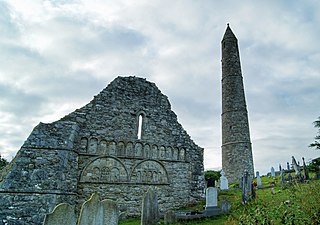
St. Declan's Monastery, containing the remains of Ardmore Cathedral, is a former monastery and National Monument located in County Waterford, Ireland.


